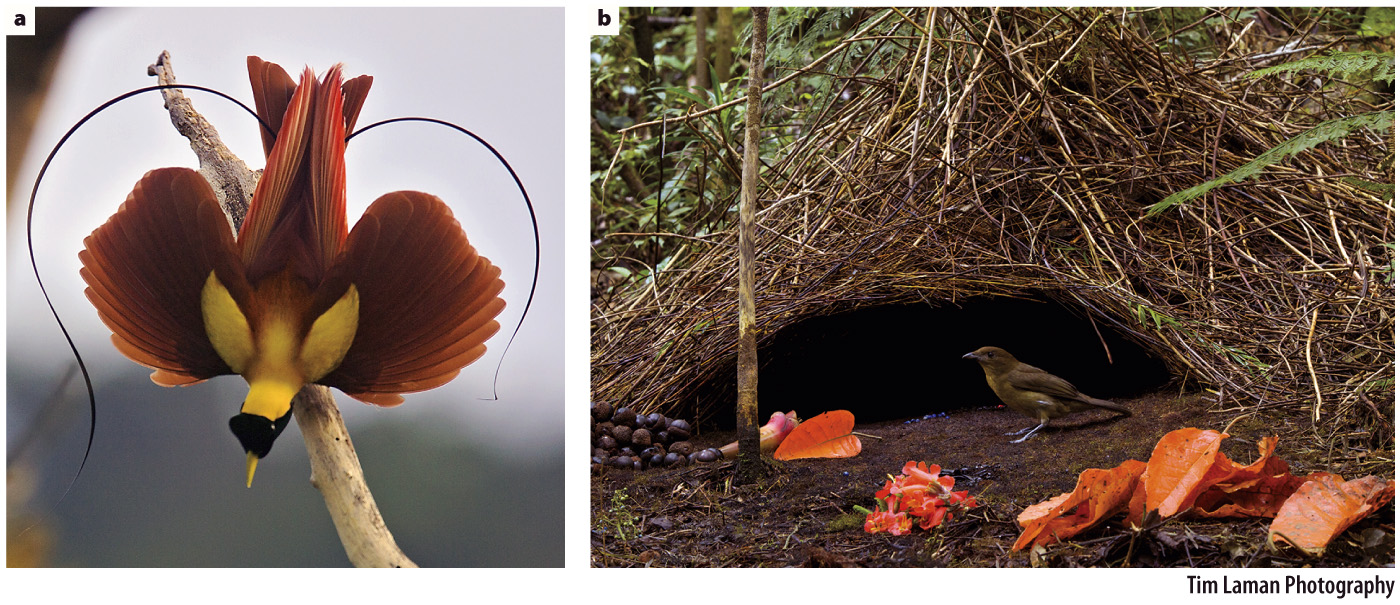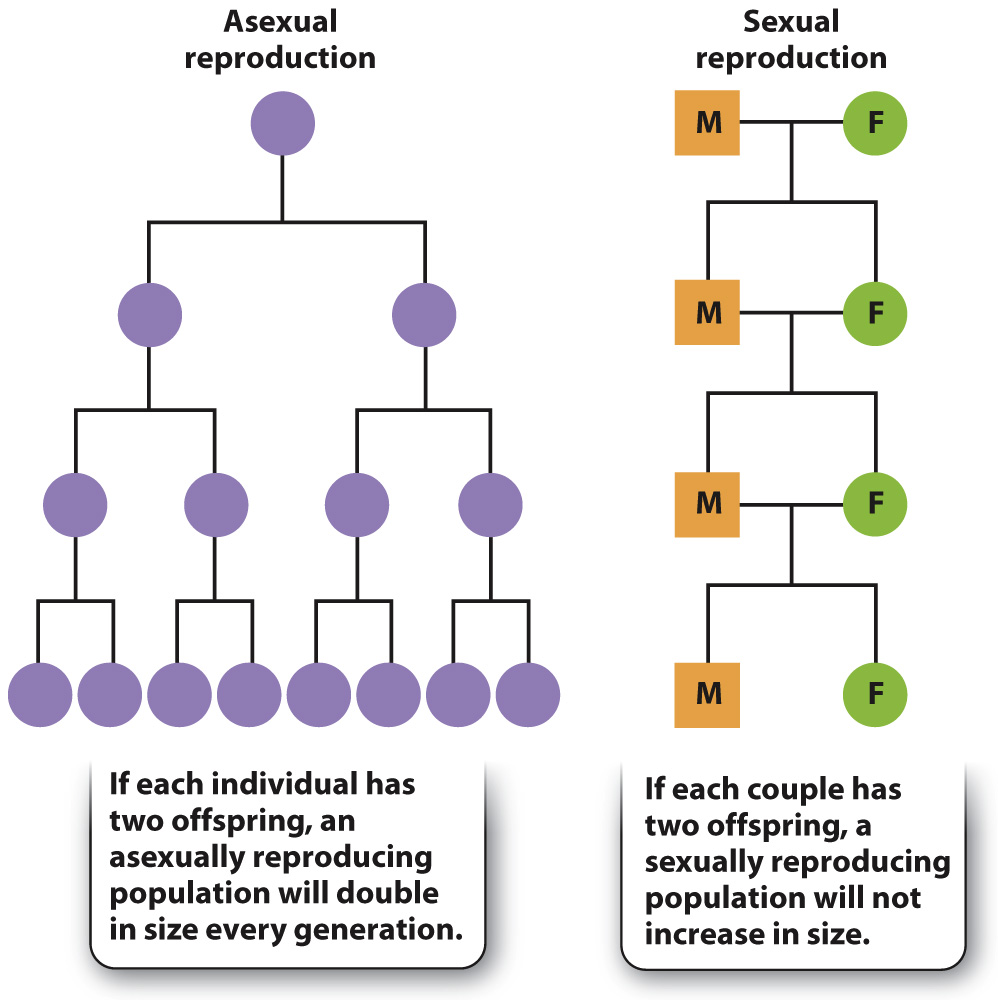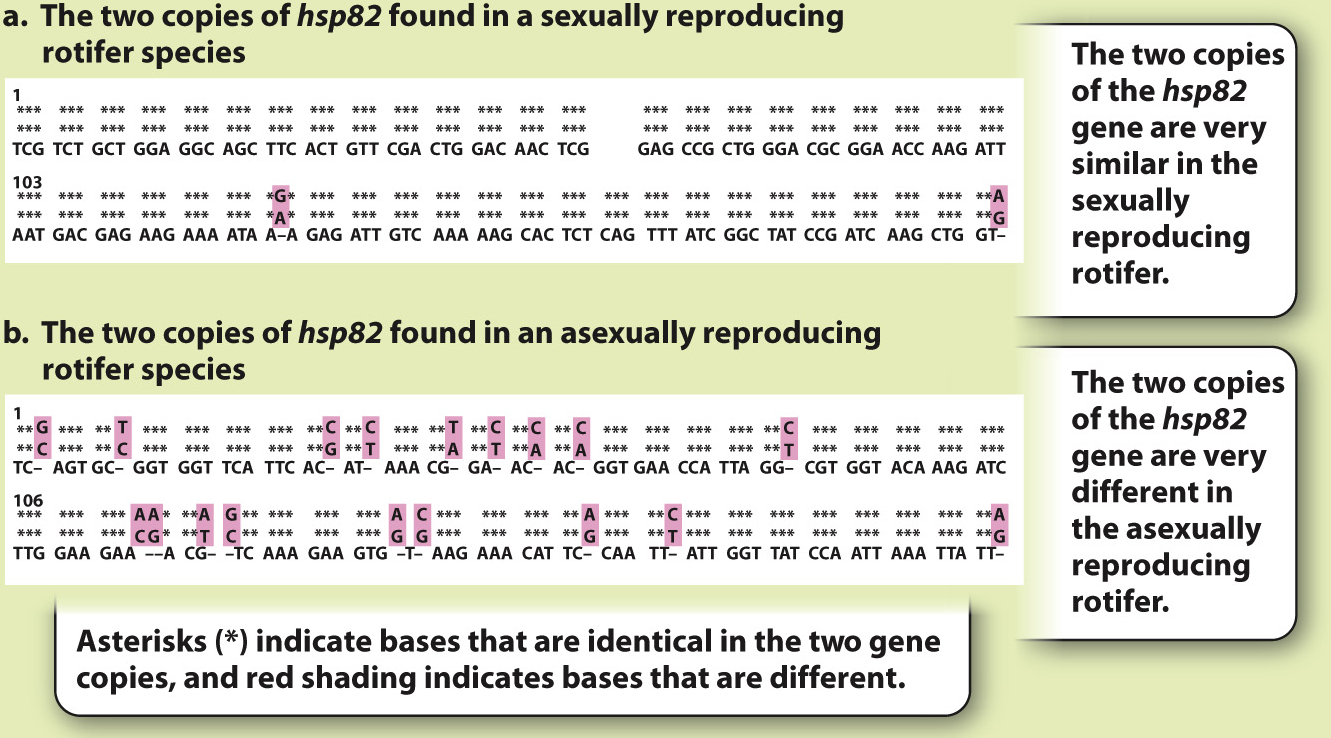Exclusive asexuality is often an evolutionary dead end.
901
Asexual reproduction has some advantages compared to sexual reproduction. It does not involve finding and attracting a mate, which takes time and energy. Certain birds, for example, go to elaborate lengths to attract mates. Male birds of paradise invest a significant amount of energy in growing colorful plumage, and male bowerbirds take time to build elaborate homes for potential mates (Fig. 42.4). For other organisms, finding a mate can be difficult because of very low population density—

In addition, asexual reproduction is rapid, allowing organisms to increase their numbers quickly. Consider rates of population growth for organisms that reproduce asexually and those that reproduce sexually. In asexual organisms, all offspring can produce more offspring, allowing for exponential population growth if conditions are favorable. By contrast, in sexually reproducing organisms, it takes two individuals to produce new offspring. The consequence of this difference is that an asexual group can have a much greater rate of population growth compared with that of a sexually reproducing one. The British evolutionary biologist John Maynard Smith called this effect the twofold cost of sex (Fig. 42.5), and it is one of the key disadvantages of sexual reproduction.

In spite of the advantages of asexual reproduction, a survey of the natural world reveals a striking pattern: Most organisms reproduce sexually at least part of the time. And even prokaryotes, as we have seen, have mechanisms for genetic exchange between individuals. The observation that the vast majority of organisms reproduce sexually at some point suggests that sexual reproduction offers advantages over asexual reproduction. Asexual reproduction is quick, but it produces offspring that are genetically identical to one another and to the parent. The only source of genetic variation is chance mutations. By contrast, one of the defining features of sexual reproduction is the production of offspring that are genetically different from one another and from their parents.
902
Many hypotheses have been developed to explain the advantages of producing genetically distinct offspring in spite of the costs of sexual reproduction. One proposes that sexual reproduction allows species to adapt faster than asexually reproducing ones because rare beneficial mutations that arise in different organisms can be brought together, increasing the overall fitness of the population. Another set of hypotheses proposes that sexual reproduction allows a population to purge itself of harmful mutations more quickly than could a population of asexual individuals.
A third hypothesis proposes that sexual reproduction is a mechanism of parasite defense. In host–
These different hypotheses for the prevalence of sexual reproduction are not mutually exclusive. It may be that several mechanisms work together, or that different ones are important for different organisms.
It is instructive to consider groups of eukaryotes that have lost the ability to reproduce sexually, and those that have lost the ability to reproduce asexually. While there are organisms such as the New Mexico whiptail lizard (Cnemidophorus neomexicanus) that reproduce only asexually, these species are not very old in evolutionary terms. In other words, there are very few, if any, ancient asexual groups. It appears that asexual reproduction on its own rarely allows a species to persist for very long in evolutionary terms.
903
A possible exception to this rule may be bdelloid rotifers, a group of microscopic freshwater invertebrates that are thought to have reproduced asexually for at least 35 to 40 million years (Fig. 42.6). If indeed bdelloid rotifers have persisted for tens of millions of years without sexual reproduction, we would predict that they have evolved some process other than sexual reproduction for increasing genetic variation. In fact, evidence suggests that they are able to take up DNA from their environment, similar to what bacteria do through transformation (Chapter 26). The bdelloid rotifers seem to be fantastic “collectors” of DNA from other organisms, including bacteria, plants, and fungi, totaling over 500 different species. However, comparison of DNA sequences among bdelloids has recently demonstrated that different individuals can share genes that are identical or almost identical in sequence, which is not possible without at least occasional sexual reproduction. More research is needed to really understand reproduction in this group.
HOW DO WE KNOW?
FIG. 42.6
Do bdelloid rotifers reproduce only asexually?
BACKGROUND Many groups of animals reproduce asexually, but most of these organisms reproduce sexually at least some of the time. The bdelloid rotifer, one of several species of microscopic aquatic animals called rotifers, may be an exception.
OBSERVATION All bdelloid rotifers found to date are females. No males or hermaphrodites (organisms with both male and female reproductive organs) have ever been observed. Meiosis has never been documented.
HYPOTHESIS Bdelloid rotifers are asexual and reproduce solely by parthenogenesis, in which unfertilized eggs develop into adult females.
PREDICTION In the absence of meiosis, the two copies (alleles) of a gene do not recombine, and mutations that accumulate are not reshuffled between them. As a result, two alleles of a gene in an asexually reproducing organism will show a much higher degree of sequence difference compared with two alleles of a gene in a sexually reproducing organism.
RESULTS Below is the sequence from the two copies of the hsp82 gene in a sexually reproducing rotifer species (Fig. 42.6a) and an asexually reproducing rotifer species (Fig. 42.6b). As can be seen, the two copies are similar in Fig. 42.6a but very different in Fig. 42.6b.

CONCLUSION The evidence from this experiment suggests that bdelloid rotifers are exclusively asexual.
SOURCE Welch, M. D., and M. S. Meselson, 2000. “Evidence for the Evolution of Bdelloid Rotifers Without Sexual Reproduction or Genetic Exchange.” Science 288 (5469):1211–
In contrast to organisms that lose the ability to reproduce sexually, mammals are unusual in the opposite way: They have lost the ability to reproduce asexually. Parthenogenesis, as we have seen, occurs in some vertebrates, but does not occur in mammals. Although parthenogenesis may seem odd from our point of view, scientists have wondered just the opposite—
Evidently not. Scientists have known for some time that mammalian maternal and paternal genomes are not quite the same. There are some genes, called imprinted genes, that are expressed differently depending on their parent of origin (Chapter 19). Imprinting ensures that mammals develop from embryos with one maternal and one paternal genome. When researchers manipulated key imprinted genes in a maternal genome, they were able to breed a parthenogenetic mouse—